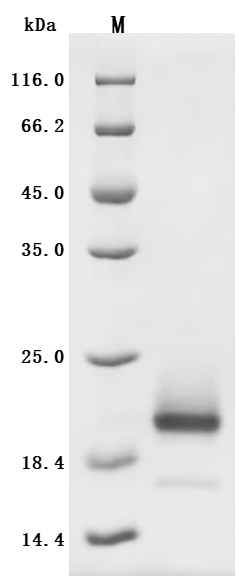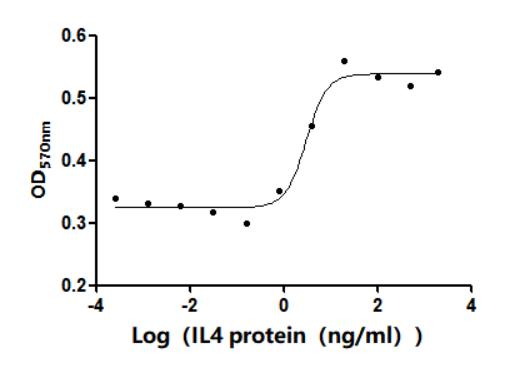The recombinant human IL4 protein is an active cytokine produced in mammalian cells, consisting of amino acids 25 to 153 of the native human IL4 sequence. It includes a 10xHis tag at the C-terminus to support efficient purification. This protein is provided in a lyophilized powder form and exhibits a purity greater than 90%, confirmed by SDS-PAGE analysis. In functional assays, it effectively promotes TF-1 cell proliferation, with an ED50 ranging between 1.864 and 4.949 ng/mL, indicating strong bioactivity.
IL4 is an important cytokine in the human immune system, primarily produced by T helper type 2 (Th2) cells, mast cells, and basophils. It plays a crucial role in regulating immune responses, particularly those associated with allergic reactions and asthma, and is encoded by the IL4 gene located on the long arm of chromosome 5 (5q31-33), an area enriched with other Th2 cytokine genes such as IL13 and IL5, indicating a coordinated regulation among these cytokines during immune signaling responses [1][2].
IL4 functions to induce the differentiation of naive T cells into Th2 cells and is pivotal in promoting B cell class switching from immunoglobulin M (IgM) to immunoglobulin E (IgE), which is critical in allergic responses [3][4]. This mechanism involves IL4 signaling through its receptor, IL-4R, which activates various transcription factors, including signal transducer and activator of transcription 6 (STAT6) and nuclear factor of activated T cells (NFAT) [5][6]. The stimulation of these transcription factors leads to increased expression of the IL4 gene itself and downstream effects that include the expression of other type 2 cytokines, enhancing the immune response against parasitic infections and allergens [7][8].
Furthermore, IL4 exhibits complex interactions within various immune contexts. For instance, it can promote the expression of proteins such as ALOX15 in monocytes, amplifying the Th2 response [9]. Conversely, it has been highlighted that IL4 may exert protective effects in autoimmune conditions by preventing cell death in pancreatic beta-cells through the activation of STAT6, showcasing its potential therapeutic applications in type 1 diabetes [10]. Additionally, variations in the IL4 gene have been linked to susceptibility to chronic conditions such as diabetes and chronic obstructive pulmonary disease (COPD) [10][11].
References:
[1] K. Książek, J. Błaszczak, & M. Buraczyńska. il4 gene vntr polymorphism in chronic periodontitis in end‐stage renal disease patients. Oral Diseases, vol. 25, no. 1, p. 258-264, 2018. https://doi.org/10.1111/odi.12974
[2] G. Pozzi, C. Carubbi, et al. Functionally relevant cytokine/receptor axes in myelofibrosis. Biomedicines, vol. 11, no. 9, p. 2462, 2023. https://doi.org/10.3390/biomedicines11092462
[3] W. Paul .History of interleukin-4. Cytokine, vol. 75, no. 1, p. 3-7, 2015. https://doi.org/10.1016/j.cyto.2015.01.038
[4] L. Hua, Q. Liu, et al. Gene–gene and gene-environment interactions on cord blood total ige in chinese han children. Allergy Asthma & Clinical Immunology, vol. 17, no. 1, 2021. https://doi.org/10.1186/s13223-021-00571-0
[5] P. Tripathi, N. Sahoo, et al. A novel mechanism for erk‐dependent regulation ofil4transcription during human th2‐cell differentiation. Immunology and Cell Biology, vol. 90, no. 7, p. 676-687, 2011. https://doi.org/10.1038/icb.2011.87
[6] J. Zhu. T helper 2 (th2) cell differentiation, type 2 innate lymphoid cell (ilc2) development and regulation of interleukin-4 (il-4) and il-13 production. Cytokine, vol. 75, no. 1, p. 14-24, 2015. https://doi.org/10.1016/j.cyto.2015.05.010
[7] A. Martín-Vega and M. Cobb. Navigating the erk1/2 mapk cascade. Biomolecules, vol. 13, no. 10, p. 1555, 2023. https://doi.org/10.3390/biom13101555
[8] P. Tangteerawatana, S. Montgomery, H. Perlmann, S. Looareesuwan, M. Troye‐Blomberg, & S. Khusmith. Differential regulation of igg subclasses and ige antimalarial antibody responses in complicated and uncomplicated plasmodium falciparum malaria. Parasite Immunology, vol. 29, no. 9, p. 475-483, 2007. https://doi.org/10.1111/j.1365-3024.2007.00965.x
[9] I. Ivanov, H. Kühn, & D. Heydeck. Structural and functional biology of arachidonic acid 15-lipoxygenase-1 (alox15). Gene, vol. 573, no. 1, p. 1-32, 2015. https://doi.org/10.1016/j.gene.2015.07.073
[10] M. Haider, M. Rushood, H. Alsharhan, M. Rasoul, M. Al-Mahdi, & H. Alkandari. Association of interleukin-4, interleukin-13 gene polymorphisms, hla-dq and dr genotypes with genetic susceptibility of type-1 diabetes mellitus in kuwaiti children. Frontiers in Pediatrics, vol. 11, 2023. https://doi.org/10.3389/fped.2023.1118137
[11] G. Korytina, Y. Aznabaeva, et al. Gene-gene and gene-environment interactions of the inflammatory gene variants in the development of chronic obstructive pulmonary disease. Global Translational Medicine, vol. 1, no. 1, p. 1-14, 2022. https://doi.org/10.36922/gtm.v1i1.91





